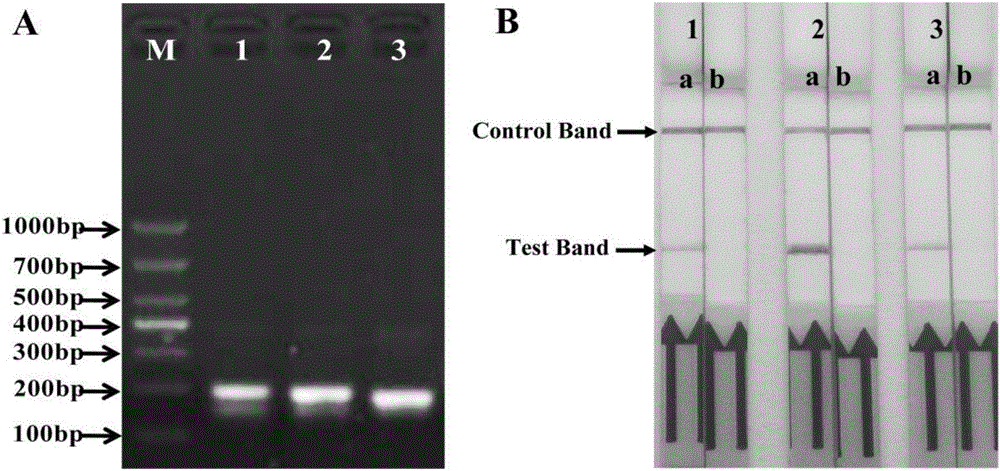Primer, probe and kit for rapidly detecting pasteurella mutocida on site
A Pasteurella, multocida technology, applied in the field of microbial detection, to achieve the effect of strong specificity, high sensitivity, and easy to use
- Summary
- Abstract
- Description
- Claims
- Application Information
AI Technical Summary
Problems solved by technology
Method used
Image
Examples
Embodiment 1
[0062] Example 1: Design and screening of primers and probes
[0063] 1. Design of primers and probes
[0064] At present, there are no specific rules for the design of RPA-nfo primers and probes, and the specificity and amplification efficiency must be tested after the RPA reaction, in order to screen and obtain primers and probes that can be used in clinical testing. In the experiment, it is necessary to design multiple pairs of primers and probes from both ends of the target sequence for optimization and screening, and the substitution or increase or decrease of individual bases will have an important impact on the experimental results.
[0065] The present invention designs primers and probes respectively according to the Kmt1 gene (GengBank No.AF016259) specific to Pasteurella multocida, see Table 1 respectively. When designing the primers, the conservation of the Kmt1 gene in the primer design region was first BLASTed on the Genebank data, all of which were 100% matched...
Embodiment 2
[0086] Example 2: Sensitivity, specificity and repeatability investigation of Pasteurella multocida RPA-LFD detection method
[0087] 1. Test method:
[0088] (1) Sensitivity detection of Pasteurella multocida RPA-LFD
[0089] Dilute the positive plasmid standard 10 times to 6.0×10 6 ~6.0×10 0 Copy / μL, use the primers and probes screened in Example 1 of the present invention to carry out RPA-nfo amplification according to the step (3) in the above Example 1, DNA is used as the template, 2 μL respectively, and pEASY-T3 empty load is negative To test the sensitivity of this method.
[0090] (2) Specific detection of Pasteurella multocida RPA-LFD
[0091] The primers and probes obtained by screening in Example 1 of the present invention are respectively effective for capsule type A Pasteurella multocida, capsule B type Pasteurella multocida, capsule D type Pasteurella multocida, capsule Pasteurella multocida type E, Pasteurella multocida type F capsular, Mycoplasma bovis, Ma...
Embodiment 3
[0104] Embodiment 3: The kit that is used for the detection of Pasteurella multocida
[0105] 1. The composition of kit: the primer and probe combination of embodiment 1 screening, positive quality control standard substance, negative quality control standard substance, rehydration buffer, magnesium acetate (280mM), ddH 2 O and lateral flow chromatography test strips.
[0106] 2. Amplification system and detection method:
[0107] The RPA-nfo reaction system is 25 μL:
[0108]
[0109] Add 23.75 μL of the above mixture into the RPA-nfo reaction tube, mix well and dissolve, and finally add 1.25 μL of 280 mM magnesium acetate solution, mix upside down and directly place it in a 37°C constant temperature water bath for 25 minutes.
[0110] After the reaction, mix 1 μL with 49 μL LFD detection buffer, immerse the LFD vertically in the above mixed buffer, and observe the results within 5 minutes. If the detection band and the control band appear at the same time, the nucleic a...
PUM
 Login to View More
Login to View More Abstract
Description
Claims
Application Information
 Login to View More
Login to View More - R&D
- Intellectual Property
- Life Sciences
- Materials
- Tech Scout
- Unparalleled Data Quality
- Higher Quality Content
- 60% Fewer Hallucinations
Browse by: Latest US Patents, China's latest patents, Technical Efficacy Thesaurus, Application Domain, Technology Topic, Popular Technical Reports.
© 2025 PatSnap. All rights reserved.Legal|Privacy policy|Modern Slavery Act Transparency Statement|Sitemap|About US| Contact US: help@patsnap.com



